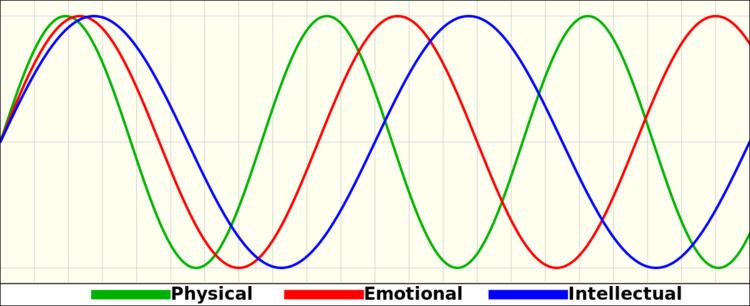 | ||
A biorhythm (from Greek βίος - bios, "life" and ῥυθμός - rhuthmos, "any regular recurring motion, rhythm") is an attempt to predict various aspects of a person's life through simple mathematical cycles. The theory was developed by Wilhelm Fliess in the late 19th century, and was popularized in the United States in late 1970s. Most scientists believe that the idea has no more predictive power than chance and consider the concept an example of pseudoscience.
Contents
Theory
According to the theory of biorhythms, a person's life is influenced by rhythmic biological cycles that affect his or her ability in various domains, such as mental, physical and emotional activity. These cycles begin at birth and oscillate in a steady (sine wave) fashion throughout life, and by modeling them mathematically, it is suggested that a person's level of ability in each of these domains can be predicted from day to day. The theory is built on the idea that the biofeedback chemical and hormonal secretion functions within the body could show a sinusoidal behavior over time.
Most biorhythm models use three cycles: a 23-day physical cycle, a 28-day emotional cycle, and a 33-day intellectual cycle. Although the 28-day cycle is the same length as the average woman's menstrual cycle and was originally described as a "female" cycle (see below), the two are not necessarily in any particular synchronization. Each of these cycles varies between high and low extremes sinusoidally, with days where the cycle crosses the zero line described as "critical days" of greater risk or uncertainty.
In addition to the three popular cycles, various other cycles have been proposed, based on linear combination of the three, or on longer or shorter rhythms.
Calculation
Theories published state the equations for the cycles as:
where
History
The notion of periodic cycles in human fortunes is ancient; for instance, it is found in natal astrology and in folk beliefs about "lucky days". The 23- and 28-day rhythms used by biorhythmists, however, were first devised in the late 19th century by Wilhelm Fliess, a Berlin physician and patient of Sigmund Freud. Fliess believed that he observed regularities at 23- and 28-day intervals in a number of phenomena, including births and deaths. He labeled the 23-day rhythm "male" and the 28-day rhythm "female", matching the menstrual cycle.
In 1904, Viennese psychology professor Hermann Swoboda came to similar conclusions. Alfred Teltscher, professor of engineering at the University of Innsbruck, developed Swoboda's work and suggested that his students' good and bad days followed a rhythmic pattern; he believed that the brain's ability to absorb, mental ability, and alertness ran in 33-day cycles. One of the first academic researchers of biorhythms was Estonian-born Nikolai Pärna, who published a book in German called Rhythm, Life and Creation in 1923.
The practice of consulting biorhythms was popularized in the 1970s by a series of books by Bernard Gittelson, including Biorhythm — A Personal Science, Biorhythm Charts of the Famous and Infamous, and Biorhythm Sports Forecasting. Gittelson's company, Biorhythm Computers, Inc., made a business selling personal biorhythm charts and calculators, but his ability to predict sporting events was not substantiated.
Charting biorhythms for personal use was popular in the United States during the 1970s; many places (especially video arcades and amusement areas) had a biorhythm machine that provided charts upon entry of date of birth. Biorhythm programs were a common application on personal computers; and in the late 1970s, there were also handheld biorhythm calculators on the market, the Kosmos 1 and the Casio Biolator. Biorhythm charts appeared in the Chicago Tribune from 1977 to 1979, and Gittelson wrote daily biorhythm charts for the Toronto Star from 1981 to 1985.
Although biorhythms have declined in popularity - opinionated pop culture magazine Vice considered them "dead" by the mid 2010s - there are free and proprietary apps and computer programs which have charting and analysis capabilities, as well as numerous websites that offer free biorhythm readings.
Critical views
There have been some three dozen studies supporting biorhythm theory, but according to a study by Terence Hines, all of those had methodological and statistical errors. Hines rejected 134 biorhythm studies and concluded that the theory is not valid.
Supporters continued to defend the theory after Hines' review, causing other scientists to consider the field as pseudoscience:
An examination of some 134 biorhythm studies found that the theory is not valid (Hines, 1998). It is empirically testable and has been shown to be false. Terence Hines believes that this fact implies that biorhythm theory 'can not be properly termed a pseudoscientific theory'. However, when the advocates of an empirically testable theory refuse to give up the theory in the face of overwhelming evidence against it, it seems reasonable to call the theory pseudoscientific. For, in fact, the adherents to such a theory have declared by their behaviour that there is nothing that could falsify it, yet they continue to claim the theory is scientific. (from Carroll's "The Skeptic's Dictionary")
The physiologist Gordon Stein in the book Encyclopedia of Hoaxes (1993) has written: "Both the theoretical underpinning and the practical scientific verification of biorhythm theory are lacking. Without those, biorhythms became just another pseudoscientific claim that people are willing to accept without required evidence. Those pushing biorhythm calculators and books on a gullible public are guilty of making fraudulent claims. They are hoaxers of the public if they know what they are saying has no factual justification."
A 1978 study of the incidence of industrial accidents found neither empirical nor theoretical support for the biorhythm model.
